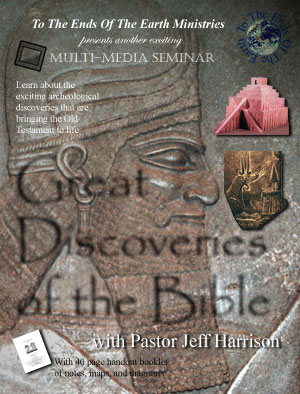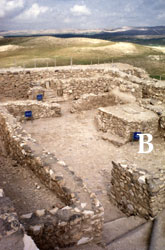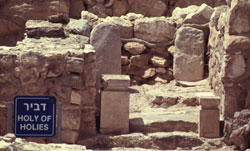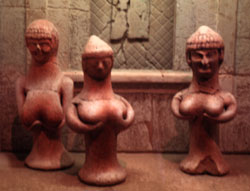Great Discoveries of the Bible
— A Landmarks of Faith Seminar —

Lecture #5b Audio
 See notes below.
See notes below.Lecture #5b:
Or click here for more listening options at Internet Archive.
__________________________
Lecture #5b Notes
SOLOMON’S TRADE (Continued)
Etzion-Geber: Solomon’s port city on the Red Sea (1 Kings 9:26). Now identified by archeologists with Pharaoh’s Island (also known as the Isle of Graye).
SOLOMON’S FALL
1 Kings 11:3: And he had seven hundred wives, princesses, and three hundred concubines, and his wives turned his heart away.
Marriage Treaty: International alliances were sealed with a marriage between one contracting king and the daughter of the other.
Hill of Evil Counsel: Modern name for the section of the Mt. of Olives directly east of the City of David on top of which Solomon built temples for his foreign wives (to the bottom right on the map of Jerusalem).
OLD TESTAMENT JERUSALEM MAP (opens in a new window)
1 Kings 11:7: Then Solomon built a high place for Chemosh the detestable idol of Moab on the mountain which is east of Jerusalem, and for Molech the detestable idol of the sons of Ammon. And he did the same for all his foreign wives...
Because of his sin, Solomon’s kingdom was split between the Kingdom of Israel in the north (the Ten Tribes) and the Kingdom of Judah in the south (Judah and Benjamin).
DAVID AND THE KINGS MAP (opens in a new window)
JEROBOAM’S CALVES
Jeroboam: Former official of Solomon who became the first king of the northern kingdom of Israel.
Rehoboam: Son of Solomon who alienated the northern ten tribes. As a result, he ruled only the southern kingdom of Judah.
1 Kings 12:28-29: So the king [Jeroboam] took counsel, and made two golden calves.... And he set one in Bethel, and the other he put in Dan"
(see the diamond shaped symbols on the map above).
Judg. 18:30: And the sons of Dan set up for themselves the graven image; and Jonathan, the son of Gershom, the son of Moses [Manasseh in some versions], he and his sons were priests to the tribe of the Danites until the day of the captivity of the land.
Discovery: The worship platform at Dan built originally for one of the golden calves. In front of it was an altar that did not conform to the instructions in the Bible: it was made of cut stone and had steps leading up to it (see Exo. 20:25-26).
Yhwh and his Asherah: Mentioned in a storage jar inscription from the 9th cent. (Kuntillet Ajrud) that says, I bless you by Yhwh of Samaria and by his Asherah.
Another inscription found at the same site says, I bless you by Yhwh of Teiman and by his Asherah.
At Khirbet el-Kom, on the wall of a tomb, was found: Blessed be Uryahu [a man’s name] by Yhwh and by his Asherah.
Yahwistic paganism: The worship of Yhwh (the God of Israel), but in a pagan way.

ARAD
Negev: A semi-desert region in southern Israel that includes the city of Beersheva and ancient Arad.
Sherd (Potsherd): Name for a broken piece of pottery. These provided a handy writing surface at a time when paper had not yet been invented. (A sherd with writing on it is known as an ostraca.)
Discovery: A sherd with writing on it that said, to the priest of the house of Yhwh in Jerusalem from the priest of the house of Yhwh in Arad.
1 Kings 14:23: They built for themselves high places and standing stones and Asherahs on every high hill and beneath every luxuriant tree.

Hosea 10:1-2: Israel is a luxuriant vine; he produces fruit for himself. The more his fruit, the more altars he made; the richer his land, the better he made the standing stones [the mazzeboth].... The Lord will break down their altars and destroy their standing stones.
Micah 5:10-13: And it will be in that day, declares the Lord, that I will...cut off your carved images and your standing stones from among you, so that you will no longer bow down to the work of your hands.

AHAB AND JEZEBEL VS. ELIJAH
(see #6 on the map)
1 Kings 18:4: It came about, when Jezebel cut down the prophets of the Lord that Obadiah took a hundred prophets and hid them by fifties in a cave...
1 Kings 17:1: As the Lord, the God of Israel lives, before whom I stand, surely there will be neither dew nor rain these years, except by my word.
1 Kings 18:21: How long will you hesitate between two opinions? If the Lord is God, follow him; but if Baal, follow him.
1 Kings 18:24: And you call out in the name of your god, and I will call out in the name of the Lord, and the god who answers by fire, he is God...
1 Kings 18:28: So they cried with a loud voice and cut themselves according to their custom with swords and lances until the blood gushed out on them.
(An attempt at sympathetic magic.)
1 Kings 18:33-34,36: And he said,
Fill four pitchers with water and pour in on the burnt offering and on the wood...and they did it a second time....and they did it a third time.... Then it came about at the time of the evening offering [in the Temple]...
1 Kings 19:10: And he said,
I have been very zealous for the Lord, the God of hosts; for the sons of Israel have forsaken your covenant, pulled down your altars and killed your prophets with the sword. And I alone am left; and they seek my life, to take it away.
1 Kings 19:12: And after the earthquake, a fire, but the Lord was not in the fire. And after the fire, the sound of a still, small voice.
1 Kings 19:17-18: And it will come about, the one who escapes from the sword of Hazael, Jehu will put to death, and the one who escapes from the sword of Jehu, Elisha will put to death. Yet I will leave seven thousand in Israel, all the knees that have not bowed to Baal and every mouth that has not kissed him.
JEHU
(see #7 on the map)
DAVID AND THE KINGS MAP (opens in a new window)
Jezreel: The winter capital of the kings of Israel (the northern kingdom).
2 Kings 9:20: ...like the driving of Jehu the son of Nimshi, for he drives furiously
2 Kings 9:22: Is it peace, Jehu?
And he answered, What peace, so long as the harlotries of your mother Jezebel and her witchcrafts are so many?
Discovery: The walled enclosure of the ancient Israelite capital at Jezreel.
Samaria: The main capital of the northern kingdom of Israel, where Jehu completed his bloody purge of the worshippers of Baal.
Discovery: The Black Obelisk, found in 1846 in Iraq, shows Jehu bowing before the Assyrian king Shalmaneser III, bringing tribute. On the obelisk, Jehu is called a son of Omri.
(Omri was the father of Ahab.)
THE ASSYRIANS
(Shalmanezer III, the Assyrian king, boasted of one of his victories: In the moat of the town I piled them up, I covered the wide plain with the corpses of their fighting men, I dyed the mountains with their blood like red wool. I took away from him many chariots and horses broken to the yoke. I erected pillars of skulls in front of his town, destroyed his towns, tore down their walls and burnt them down
(ANET, p. 277).
Jonah: Prophet to the Assyrians in the early 8th cent. BC. His message of repentance in Nineveh was accepted.
Sargon: Assyrian ruler that conquered the northern kingdom of Israel after a three-year siege of Samaria, its capital city (721 BC; see #8 on the map above). Many of the people were deported; and so came to be known as the ten lost tribes of Israel.
HEZEKIAH’S PREPARATIONS
Discovery: Hezekiah’s Tunnel, which brought water from the Gihon Spring into the city of Jerusalem.
OLD TESTAMENT JERUSALEM MAP (opens in a new window)
Discovery: A ninety-six foot section of the wall built by Hezekiah (the Broad Wall
) to enclose the Western Hill.
Isaiah 22:10-11: Then you counted the houses of Jerusalem, and you tore down houses to fortify the wall. And you made a reservoir between the two walls [at the end of Hezekiah’s tunnel] for the waters of the old pool. But you did not depend on him who made it, nor did you take into consideration him who planned it long ago.
Western Hill: A large western addition to the city of Jerusalem that was walled about by Hezekiah in preparation for an Assyrian attack (see Jerusalem map).
Discovery: Jar handles impressed with Hezekiah’s royal seal. These jars were probably used to store supplies in preparation for an Assyrian siege.
LACHISH
(see #9 on the map)
DAVID AND THE KINGS MAP (opens in a new window)
Discovery: Sennacherib’s palace reliefs (the Lachish reliefs) illustrating his victory over Lachish. Placed in the most important room of his palace at Nineveh (discovered in the early 1850’s, now in the British Museum in London).
Discovery: The Assyrian siege ramp at Lachish.
2 Kings 18:28: Then Rabshakeh stood and cried out with a loud voice in Judean...
2 Kings 19:32-33: He will not come to this city or shoot an arrow there; neither will he come before it with a shield, nor throw up a mound [a siege ramp] against it. By the way that he came, by the same he will return, and he will not come to this city.
2 Kings 19:35: And it happened that night that the angel of the Lord went out, and struck 185,000 in the camp of the Assyrians; and when men rose early in the morning, look, all of them were dead.
MANASSEH
2 Kings 2:21: For he [Manasseh] rebuilt the high places that Hezekiah his father had destroyed; and he erected altars for Baal and made an Asherah, as Ahab king of Israel had done, and worshipped all the host of heaven and served them.... For he built altars for all the host of heaven in the two courts of the House [the Temple] of the Lord.
INVASION OF NEBUCHADNEZZAR
(see #10 on the map)
DAVID AND THE KINGS MAP (opens in a new window)
Discovery: The Lachish ostracons (letters written on potsherds) found in the gate of the city of Lachish that were never delivered. One said, Let my lord know that we are watching over the beacon of Lachish, according to the signals that my lord gave, for Azekah is not to be seen.
Jer. 34:6-7: Then Jeremiah the prophet spoke all these words to Zedekiah king of Judah in Jerusalem when the army of the king of Babylon was fighting against Jerusalem and against all the remaining cities of Judah, that is, Lachish and Azekah, for they alone remained as fortified cities among the cities of Judah.
Discovery: A layer of ash from the Babylonian destruction of Jerusalem. It contained three iron Israelite arrowheads, and one bronze Babylonian arrowhead.
Lamentations 1:1; 2:2,4-5,15: How lonely sits the city that was full of people. She has become like a widow who was once great among the nations.... The Lord has swallowed up, he has not spared all the habitations of Jacob. In his wrath he has thrown down the strongholds of the daughter of Judah; he has brought them down to the ground.... The Lord has become like an enemy. He has swallowed up Israel; he has swallowed up all its palaces; he has destroyed its strongholds and multiplied in the daughter of Judah mourning and moaning.... All who pass along the way clap their hands in derision at you; they hiss and shake their heads at the daughter of Jerusalem...
Discovery: Seal impressions found in the ruins of the city of Jerusalem (City of David, Area G) made by the seals of the scribe of Jeremiah, Baruch son of Neriah, and of Gemariyahu, the son of Shaphan, both of whom are mentioned in Jer. 36:10.
Discovery: A toilet in use at the time of the siege. The dirt underneath provided evidence that during the siege of Jerusalem, pinworm and tapeworm increased dramatically among the people of the city. A diet of agricultural produce was replaced with weed grass growing in the streets and squares. (City of David, Area G).
2 Kings 25:3: The famine was so severe in the city that there was no food for the people...
Psalm 136:1: By the rivers of Babylon, there we sat and wept when we remembered Zion.
After the return of the exiles from Babylon, archeologists have not found a single idol in any of the areas Jewish people were living, and not a single Jewish high place, except the Temple in Jerusalem.